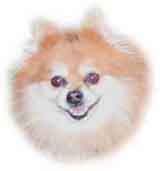Small Dog BreedsInformation About The Pomeranian Dog Breed |
|
|
The Pomeranian is a happy and active little dog that can adapt cheerfully to life in a one bedroom apartment or a spacious home, loving the role of a lap dog or enjoying walks with its owner. Alternatively, he will amuse himself adequately in the yard. He makes a faithful and devoted addition to the family. Size: The average size of the Pomeranian male is 4-41/2 lbs while the average size of the female is 41/2-51/2 lbs. History and origin: The Pomeranian takes his name from Pomerania in Germany and is generally thought to be mid-European origin. However, it is a member of the Spitz family, which could mean that its history started in the Arctic Circle. The known history of the breed dates back from the mid-18 th century when it was introduced to several European countries. The dog became very popular until following the raiding of the Summer Palace in Peking in 1860 and the appearance of the Imperial Pekingese, some of its popularity was usurped by that breed. The Pomeranian in those early times was a very much larger dog which weighs up to 30lb and was bred down until by 1896, show classes for Pomeranians were divided into those for exhibits over and under 8lb. The British Kennel Club withdrew challenge certificates for the over 8lb variety in 1915. The American Pomeranian club was formed in New York in 1900. Feeding: Recommended feeding for the Pomeranian is 1/3-1/2 can (13.3oz size) of a branded meaty product, with biscuits added in equal part by volume or 1-11/2 cups of dry food. Exercise: Although Pomeranians love to be pampered and petted on their owner's lap, they are also lively little dogs who can walk as far as their owner would wish and often farther. They get plenty of enough exercise by themselves running around inside the house. Grooming: This is not the dog for those with a busy lifestyle and cannot spare the time for daily grooming. The Pomeranian has two coats to care for; a short fluffy undercoat and a long straight topcoat covering his entire body. Daily brushing with a stiff brush is required. The coat should be damped with cold water and the moisture rubbed in with the fingertips. Finally, the dog is rubbed down with a towel. Working from the head, part the coat and brush it forward from roots to tips. Make a further parting and repeat the procedure until the whole body has been covered. In addition, regular trimming is also necessary to keep his coat in good condition. If you are interested in training your pomeranian, then we suggest that you consider Pomeranian Training. Back to the Small Dog Breed page
| |
|
Related News About Dogs ' ); // get rid of newsfeed display by carp CarpConf('poweredby',''); CarpCacheShow('http://www.small-dog-info.com/support-files/rss.xml'); ?>
|
|
|
|
|
|
Copyright © 2006-2007 dogguidance.com |


